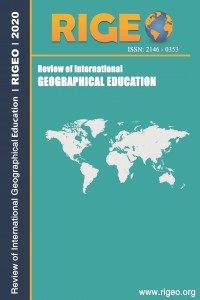Experiential In-service Teachers’ Training for the Pilot of the New Geography Curriculum in Greece: A Different Experience with Tangible Results
Experiential In-service Teachers’ Training for the Pilot of the New Geography Curriculum in Greece: A Different Experience with Tangible Results
Τhe aim of this paper is to present the design and the results of the In-service Elementary Teacher
(IET) training seminars, in Geography for primary education, during the pilot of the New Geography
Curriculum (NGC) in Greek schools, the school year 2011-2012. The design of this training was based
on the documented needs of teachers for training in a practical and experiential way and to meet with
teamwork. Teachers, who participated in these training sessions, reviewed positively the experiential
nature of the training courses, created 36 new Geography lesson plans on a voluntary basis, and most
of them incorporated tools and teaching methods they had experienced in the seminars. These results
could provide guidance for a successful in-service teacher training course in all subjects and not just
for Geography.
Keywords:
In-service training, primary education, teachers geography curriculum, Greece,
___
- Brand, B. R. & Moore, S. J. (2011). Enhancing Teachers’ Application of Inquiry-Based Strategies Using a Constructivist Sociocultural Professional Development Model. International Journal of Science Education, 33(7), 889-913.
- Bell, T., Urhahne, D., Schanze, S. & Ploetzner, R. (2010). Collaborative Inquiry Learning: Models, tools, and challenges. International Journal of Science Education, 32(3), 349- 377.
- Brook, D. L. (1977). Students’ attitudes towards geography. Journal of Social Studies Research, 1(2), 60–69.
- Chalkia, K. (2010). Teaching Science – Theoretical issues, concerns, suggestions. Athens: Pataki. (in Greek)
- Cohen, L., Manion, L. & Morrison, K. (2007). Research Methods in Education, 6th ed. Oxford, UK: Routledge Publishers, 475-495.
- Condie, R., Munro, B., Seagraves, L. & Kenesson, S. (2007). The impact of ICT in schools - a landscape review. UK: Becta Research.
- Dean, D. Jr & Kuhn, D. (2006). Direct Instruction vs. Discovery: The Long View. Science Education, 91(3), 384-397.
- Goodchild, M.F. (2006). The fourth R? Rethinking GIS education. ArcNews, 28(3), (1) & (5). Available at http://www.esri.com/news/arcnews/fall06articles/the-fourth-r.html (Accessed on December 27, 2013)
- Hespanha, S.R., Goodchild, F. & Janelle, D.G. (2009). Spatial Thinking and Technologies in the Undergraduate Social Science Classroom. Journal of Geography in Higher Education, 33(S1), S17-S27.
- Katsikis, Α. (2004). Inter-disciplinary Geography. Athens: Typothito. (in Greek)
- Klonari, A. (2004). Compulsory and secondary educators’ ideas concerning Geography as a school subject. Proceedings of the 7th Pan-Hellenic Geography Congress, Greek Geographic Association, 603-610 (in Greek).
- Klonari, A. & Koutsopoulos, K. (2005). Primary and secondary educators’ attitudes on school geography. In K. Donert & P. Charzynski (Ed.), Changing horizons in geography education, 151–155. Torun, Poland: Herodot Network.
- Klonari, A., Mandrikas, Α., Melista, Α. & Tzoura, M. (2014). One year pilot implementation of the new Greek geography curriculum in primary education. European Journal of Geography, 5(1), 81-97.
- Lambrinos, N., Chadzipantelis & Gratsonidis, A. (2002). 6th Grade Primary School students’ Views on the Subject of Geography. Modern Education, 122, 102–108. (in Greek)
- Lee, H.-S. & Butler-Songer, N. (2003). Making authentic science accessible to students. International Journal of Science Education, 25(8), 923-948.
- Lee, J. & Bednarz, R. (2009). Effect of GIS Learning on Spatial Thinking. Journal of Geography in Higher Education, 33(2), 183-198.
- Lemberg, D. & Stoltman, J. (1999). Geography teaching and the new technologies: opportunities and challenges. Journal of Education, 181(3), 63-76.
- Linn, M. C. (2003). Technology and science education: Starting points, research programs, and trends. International Journal of Science Education, 25(6), 727-758.
- Marble, S. (2007). Inquiring into Teaching: Lesson Study in Elementary Science Methods. Journal of Science Teacher Education, 18(6), 935-953.
- Minstrell, J. & Van Zee, E. H. (eds). (2000). Inquiring into Inquiry Learning and teaching in Science. Washington, DC: American Association for the Advancement of Science.
- National Research Council (2006). Learning to Think Spatially: GIS as a Support System in the K–12 Curriculum. Washington, D.C.: The National Academies Press.
- Nelson, Μ. Μ. & Davis, Ε. Α. (2012). Preservice Elementary Teachers' Evaluations of Elementary Students' Scientific Models: An aspect of pedagogical content knowledge for scientific modeling. International Journal of Science Education, 34(1)2, 1931-1959.
- Okuranstifa, P. O. (1975). A pilot study of Nigerian pupils’ attitude toward and achievement in a programmed unit of geography, Journal of Negro Education, 44(4), 538–546.
- Ozdemir, U. (2012). High School Students’ Attitudes towards Geography Courses, World Applied Sciences Journal, 17(3), 340-346.
- Paraskevas, A., Lambrinos, N. & Psillos, D. (2010). A study of a blended didactic approach to teacher professional development in Geography. European Journal of Geography, 1, 46-60.
- Rogers, A. (1998). Teaching adults. Open University Press.
- Sack, D. & Petersen, J. F. (1998). Children’s attitudes toward geography: A Texas case study. Journal of Geography, 97(3), 123–131.
- Stemler, S. (2001). An overview of content analysis. Practical Assessment, Research & Evaluation, 7 (17), 1-9.
- Sternberg, R. J. & Grigorenko, E. L. (2007). Teaching for successful intelligence. Thousand Oaks, CA: Sage Publications.
- Sternberg, R. J. & Spear-Swerling, L. (1996). Teaching for thinking. Washington, D.C.: American Psychological Association.
- Taylor, L. (2001). ICT in Geography. UK: Pearson Publishing.
- Villegas-Reimers, E. (2003). Teacher professional development: an international review of the literature. Paris: UNESCO: International Institute for Educational Planning.
- ISSN: 2146-0353
- Başlangıç: 2011
- Yayıncı: Eyüp ARTVİNLİ
Sayıdaki Diğer Makaleler
Tim FAVIER, Joop VAN DER SCHEE
Global Citizenship Education in a Secondary Geography Course: The Students’ Perspectives
Geography in Secondary Schools: Researching Pupils’ Classroom Experiences
Aikaterini KLONARI, Achilleas MANDRIKAS
